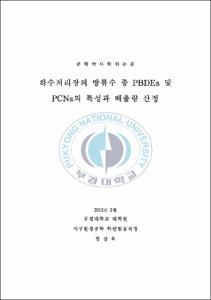하수처리장의 방류수 중 PBDEs 및 PCNs의 특성과 배출량 산정
- Alternative Title
- Characteristic and discharge amount estimation of PBDEs and PCNs in sewage effluent
- Abstract
- The international community is making an endeavor to regulate the persistent organic pollutants(POPs) which are generated as by-products. Korea is also under an obligation to carry out the Stockholm convention demanding for discharge inventories and cutback management.
Therefore Korea is in the process of national fulfillment program.
Some congeners of theses polybrominated diphenyl ethers(PBDEs) were added to the list of emerging POPs. Polychlorinated naphthalene (PCNs) are not restricted by discharge controls yet, however some countries recommend them as emerging POPs.
There haven’t been sufficient studies and data dealing with PBDEs and PCNs not only to Korea, but also entire world in the part of sewage treatment.
PBDEs have been added as flame retardants to consumer products and other materials such as electronic equipments, textiles and furniture. These compounds are bio accumulative and may also interfere with endocrine system function and thyroid hormone. Deca-BDE is constituted as dominant congener. This congener has been considered that breakdown products having high toxicity could be created, although its toxicity is low.
PCNs are manufactured by synthesis between chlorine and naphthalene based on petroleum or coal. These compounds were used mainly as mothproofing materials. PCNs were used worldwide in 1910s. After decades, these compounds were reported occurrence of serious skin rashes and disorder of the livers and bowels.
The actual state of PBDEs and PCNs of the sewages and sledges was studied. The method of estimating for discharge amount was used to evaluate precise influence on the environment by PBDEs and PCNs of effluence and dehydrated cake from the sewage treatment facilities by regional groups in Korea.
Furthermore theoretical investigation with former studies about PBDEs and PCNs was carried out to confirm a recent trend and characteristics of the sources.
The analytical results and characteristic were proposed with the concentrations of PBDEs and PCNs according to the media. With these consequences, discharge factors were calculated and discharge amount were suggested.
Deca-BDE(209-BDE), which is used the most in Korea, was dominant congener.
The homologue profile pattern showed that deca-BDE, nona-BDE, penta-BDE and tetra-BDE were detected in order of contribution. Most PBDEs were flowed into the facilities with particle phases.
The concentration of PBDEs in effluence from the facilities were ranged 0.24~0.56 ng/L in dissolved phases and 0.46~5.72 ng/L in particle phases. Deca-BDE(209-BDE) was also dominant congener in effluence.
The homologue profile patterns of PBDEs in these domestic sewage treatment facilities were analogous trend. Contribution to total concentration by particle phases was increased toward the high brominated BDEs.
The profile pattern showed that 1-PCNs were predominant congeners and dissolved phased contributed to the concentration.
Discharge amount of PBDEs from domestic sewage treatment facilities were estimated at 224.71 kg/year. The calculated discharge amounts was 127.1 kg/year in the Capital area, 40.73 kg/year in Yeongnam area, 19.36 kg/year in Chungcheong area, 14.99 kg/year in Honam area and 22.53 kg/year in the rest of Korea, respectively. The total discharged amount of PBEDs from these facilities was classified by path way. The discharge of PBDEs thorough water body, such as effluence and sea dumping, was 140.8 kg/year. Air emission of PBDEs by incineration was 35.35 kg/year and landfill was 7.78 kg/year. Total amount of reuse of PBDEs in various field of industry was estimated with 40.79 kg/year.
- Issued Date
- 2012
- Awarded Date
- 2012. 2
- Type
- Dissertation
- Publisher
- 부경대학교 대학원
- Alternative Author(s)
- Sang - Ug Yeom
- Department
- 대학원 지구환경공학학ㆍ연협동과정
- Advisor
- 옥곤
- Table Of Contents
- 목 차
List of Tables ⅲ
List of Figures ⅵ
Abstract 1
제1장 서 론 5
1.1. 연구배경 5
1.2. 연구 필요성 및 목적 8
1.3. 연구범위 및 논문구성 9
제2장 이론적 고찰 10
2.1. PBDEs 및 PCNs의 물리화학적 특성 10
2.1.1. PBDEs 개요 10
2.1.2. PBDEs의 물리화학적 특성 23
2.1.3. PCNs 개요 31
2.1.4. PCNs의 물리화학적 특성 32
2.2. PBDEs 및 PCNs의 독성학적 특성 34
2.2.1. PBDEs 독성 34
2.2.2. PBDEs의 독성 영향평가 34
2.2.3. PCNs 독성 44
2.3. 분석대상 물질 및 독성등가환산계수 45
제3장 시료채취 및 분석방법 47
3.1. 시료채취 대상 시설의 개요 및 공정 특성 47
3.1.1. A 하수처리장 48
3.1.2. B 하수처리장 52
3.1.3. C 하수처리장 55
3.1.4. D 하수처리장 58
3.2. 시료 채취시설의 선정 61
3.3. 분석방법 62
3.3.1. PBDEs 및 PCNs 전처리 방법 62
3.3.2. PBDEs 및 PCNs의 기기분석 67
3.3.3. 정도관리 74
제4장 연구결과 및 고찰 75
4.1. 하수처리장에서의 PBDEs 및 PCNs의 배출특성 75
4.1.1. 유입수 중 PBDEs의 농도분포 75
4.1.2. 방류수 중 PBDEs 의 농도분포 84
4.1.3. PBDEs의 분포 특성 93
4.1.4. 유입수 중 PCNs의 농도분포 99
4.1.5. 방류수 중 PCNs의 농도분포 102
4.1.6. PCNs의 분포 특성 105
4.2. PBDEs 및 PCNs 의 배출량 산정 111
4.2.1. 배출계수 113
4.2.2. 활동도 114
4.2.3. 배출량 산정 118
제5장 결론 및 제안 142
참 고 문 헌 146
감사의 글 152
- Degree
- Doctor
- Appears in Collections:
- 대학원 > 지구환경공학연협동과정
- Files in This Item:
-
-
Download
 하수처리장의 방류수 중 PBDEs 및 PCNs의 특성과 배출량 산정.pdf
기타 데이터 / 2.55 MB / Adobe PDF
하수처리장의 방류수 중 PBDEs 및 PCNs의 특성과 배출량 산정.pdf
기타 데이터 / 2.55 MB / Adobe PDF
-
Items in Repository are protected by copyright, with all rights reserved, unless otherwise indicated.